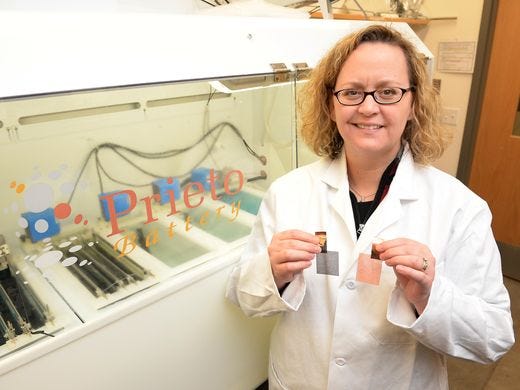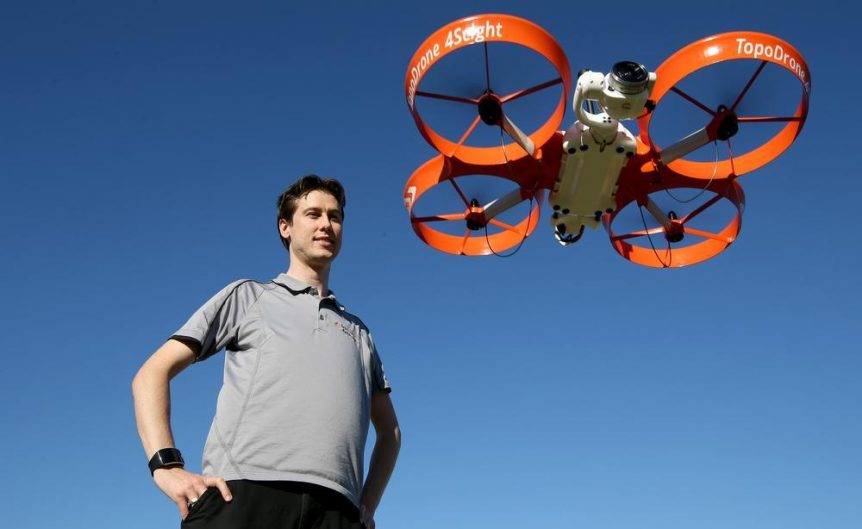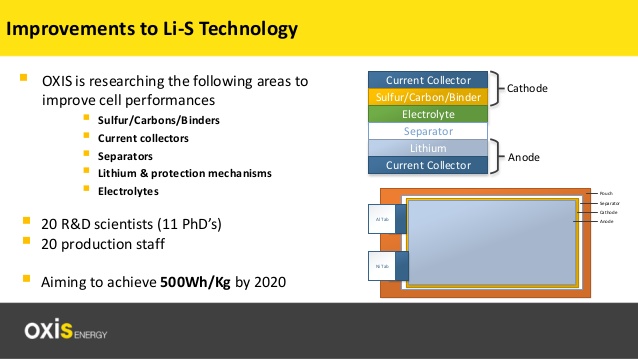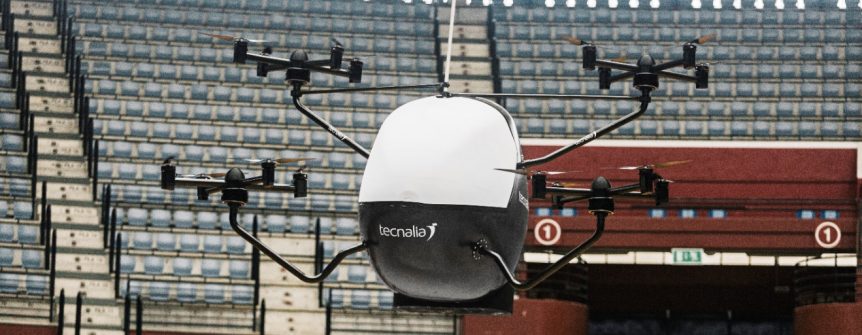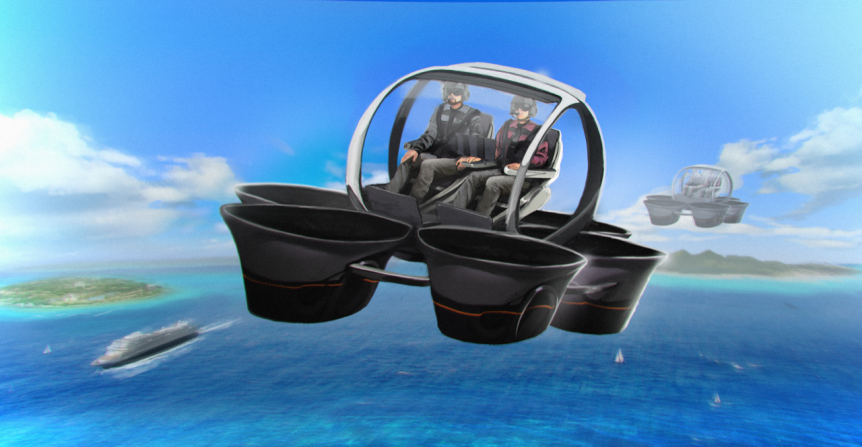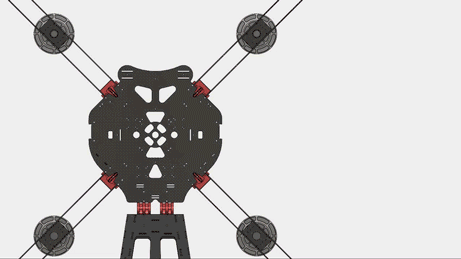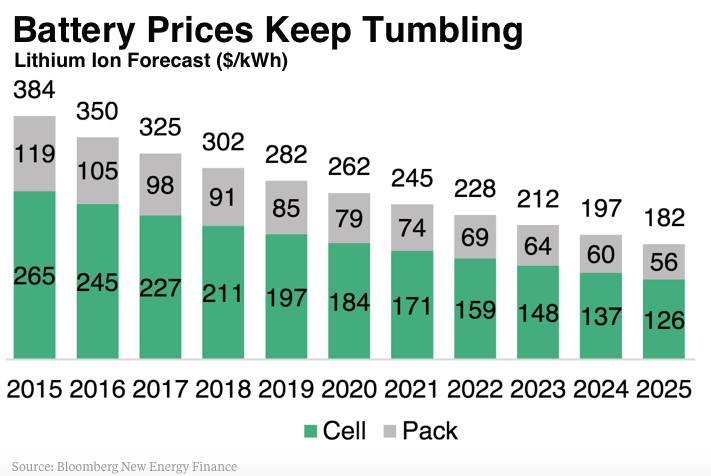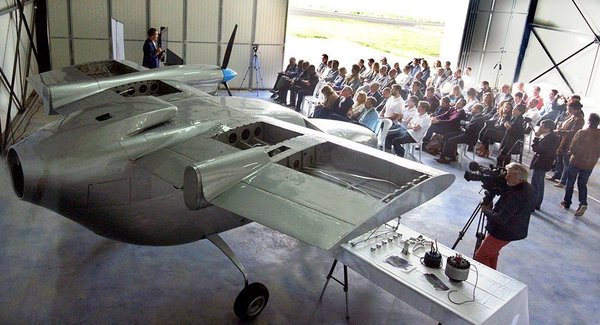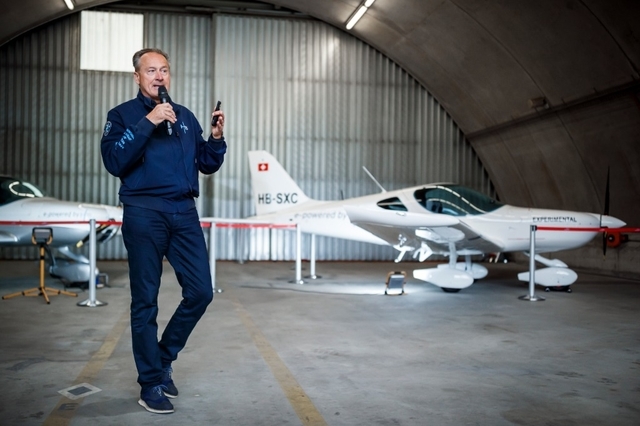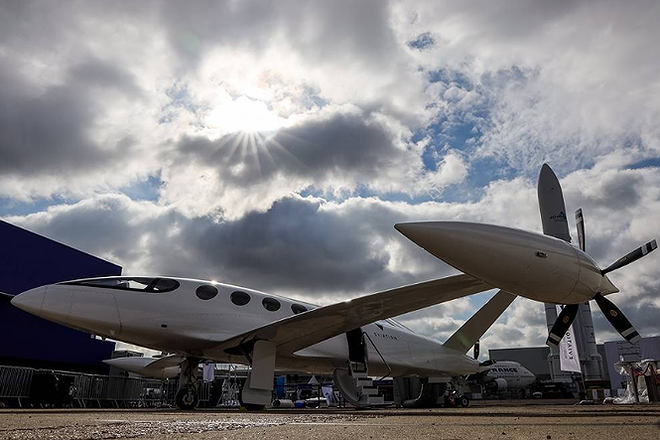Dr. Amy Prieto created her namesake battery a decade ago, and has been seeking funding and other support for its development ever since. It gained such funding from Stanley Ventures in 2016. Prieto Battery, as reported by GreenCarCongress.com then, is, “A company commercializing a 3D Lithium-ion battery technology (earlier post), announced a strategic investment from Stanley Ventures, the venture arm of Stanley Black & Decker, a world-leading provider of tools and storage, commercial electronic security and engineered fastening systems.” Possibly more important that money, Dr. Prieto’s battery recently received third-party validation of its claimed safety and performance attributes from Energy Assurance, LLC. GreenCarCongress reports, “Specifically, Prieto had a group of fully assembled batteries containing their proprietary 3D anode tested against an array of UL (Underwriters Laboratories) and IEC (International Electrotechnical Commission) standards for Li-ion chemistry. All of Prieto’s batteries had 100% success rate with zero failures.” Dr. Prieto seems happy with these results, stating, “These results validate the science and manufacturing …
A L.E.A.P. Forward for Electro.Aero
Heady Ambitions Joshua Portlock, Co-founder, Director and Chief Technology Officer for Electro.Aero in Perth, Australia, has a heady set of ambitions. He and Rob Belaga presented a simple electric vertical takeoff and landing machine, FlyKart, at two different symposia in northern California two years ago, and presented a refined version for the Boeing GoFly competition shortly thereafter. They’ve made it to the finals of the $2,000,000 contest and will be in the February, 2020 flyoff. In the meantime, he’s started a flight training program using Pipistrel’s Alpha Electro trainer, and is partnering with an almost bewildering set of industry, government and academic leaders, including Ampaire, Bye Aerospace, E/S/Aero, NASA, Pipistrel, University of Western Australia, and Zero Emissions Vehicles Australia. Joshua gives a rundown in his down-under TED Talk. Working with ducted fan systems leads to a redesign of a Diamond DA-40 that ditches the internal combustion engine in the nose for a battery pack. One ducted fan behind and on …
OXIS Energy, Bye Aerospace Develop Lithium-Sulfur Cells
Diane Simard, Senior Vice President and a member of the Board of Directors for Bye Aerospace, sends your editor occasional news from that company. The latest involves a collaboration with OXIS Energy in England to develop new Lithium-Sulfur battery cell technology that shows great, and (even better) near-term promise. Ready to start in September, the project will develop cells that will, ”Achieve the higher energy density required for such aircraft,” referring to Bye’s eFlyer 2 and eFlyer 4 light aircraft. A big jump over currently available batteries, OXIS is now evaluating cells that produce 400 Watt-hours per kilogram, with a promised leap to 500 kW-hr by next year. The best lithium-ion cells at the pack level available now manage 260 W-hr/kg. Huw W. Hampson-Jones, CEO of OXIS Energy, discusses his company’s unique approach to battery development and what this portends for future flight and general electric mobility. Explaining OXIS’s applications, he adds, “Aviation is one of OXIS’ target markets, and …
Tecnalia Aerotaxi Levels with Reasonable Goals
Tecnalia, a Spanish technology and engineering firm, presented its Aerotaxi at the Paris Air Show this year. The company demonstrates a way to make automated flight a little less perturbing to the anxious public, keeping the platform on the straight and level during all phases of flight. It does this with four gimbaled sets of four propellers, which do all the pivoting and changes of angle while leaving the passenger compartment in a constant plane. This should do a great deal to calm the reluctant flyer. Tecnalia adds, “Joseba Lasa, one of the people responsible for the development, explained that “the main novelty of Tecnalia’s aircraft lies in the fact that the architecture allows the cabin to maintain its orientation regardless of speed, a clear advantage over conventional drones and current ‘air taxi’ applications. This feature enhances the flying experience, providing a sensation similar to that of travelling by car or bus from a dynamic point of view.” Aerotaxi has …
EJ-1, A Circle of Power
Consider encircircling yourself with a ring of tiny electric motors turning a collection of well-coordinated thrusters. Electric Jet Aircraft of Anderson, Indiana showed off their vehicle, claimed to be the world’s first wearable electric jetpack – the EJ-1, at Oshkosh, Wisconsin during this week’s AirVenture air show. A 16-motor, battery-powered rig that weighs around 100 pounds, depending on the battery pack, it’s made to fly several feet off the ground while carrying a 200-pound pilot. The product of 13 years of preliminary design and innovation, the aircraft was test flown before its introduction at the Urban Mobility Showcase at the show. Composed of four “JetPods,” modules of four electric motors and associated controllers that produce 80 pounds of thrust each, the EJ-1 can logically lift 320 pounds, leaving adequate excess thrust for its 200-pound payload to give a good climb to its fairly low “cruising altitude.” Flight duration is limited, but a lighter pilot should be able to add larger …
Open PPG Rev. 4
An Open Source Project Powered paragliders (ppg) have been a relatively inexpensive and fairly reliable method of getting off the ground for several decades. The OpenPPG organization enables one to be part of a group effort to improve a simple, light framework and power systems as part of a group effort. The group’s web site proclaims, “The OpenPPG project is the solution to easy, convenient, and affordable powered paragliding. With its simple user-friendly, maintenance free, and lightweight design it has never been safer and easier to experience the thrill of flight.” Here we see the first flight of the rev. 3 model. The body-cam is a bit distracting, but does give a view of the steps required to ready the machine for flight. A second video shows two paramotors in flight, demonstrating great control (on a probably very calm day), and almost vibration free images because of the craft’s small electric motors. How well will one of these things climb? A pilot starting at a 4,400 …
Total Operating Costs – Batteries Included
Gilles Rosenberger, co-founder of Faraday Aerospace with Michael Friend, former Technology Director for Boeing, commented on a recent entry on H55’s Energic two-seat trainer. He expanded on the idea of total operating costs for electric aircraft, including the battery replacement. He congratulated the H55 team and added a point about which your editor will attempt greater diligence. “But why keeping talking about operating cost and not total cost of ownership? No pilot, no student is going to pay only few dollars per hours based on the energy cost. Who do you believe is going to pay for other cost including the battery amortization?” Practicing the best public relations and salesmanship gambits, most aircraft sales operations don’t mention the eventual cost of battery replacement. Gilles, who can speak from experience because of his work on the Airbus E-Fan project, says, “Best industry standards seem to be today 1.000 € (or $1,125) per kWh for a 1,000 cycles non-certified battery pack.” What …
Volt Aero Cassio Hybrid – From France
You may have noticed an ongoing divide in electric aircraft philosophies, that of designing from a blank sheet, or that of converting an existing airplane from fossil fuel to electric power. French company VoltAero has chosen the second path with its Cassio. A conversion of a Cessna 337 Skymaster, it shares similarities to Ampaire’s 337 conversion, with significant differences in its power configuration. What has Five (Three?) Motors and Three Propellers? Ampaire’s 337 conversion retains the “push-pull” arrangement of the original, with the “pusher” an electric power unit behind the cabin and between the twin tail booms. VoltAero’s replaces the front engine with a faired, engineless nose and one REX 60-kilowatt (80.4 horsepower) electric motor on the nose of each boom. According to Flyer magazine, Cassio 1 now has a single electric motor coupled to an internal-combustion engine bringing up the rear. “The prototype Cessna-based Cassio has two 60kW motors driving two forward facing propellers on the wing. A hybrid …
Borschberg, H55 Introduce BRM Energic
Leadership is about empowering people to make them owner of their world, and constantly challenging them to make them extend their known territory.” Andre’ Borschberg Andre’ Borschberg’s current challenge, shared with Bertrand Piccard, involves their Solar Impulse Foundation, whose goal is to foster 1,000 solutions “that protect the environment in a profitable way.” “Profitable” helps produce results, and with Piccard being a psychiatrist, ensures the self-interest that drives many also drives a certain level of altruism in saving the environment. Borschberg and two other Solar Impulse leaders, Sébastien Demont and Gregory Blatt, founded H55 and produced a modification of the Silence Twister, a single-seat aircraft with a Siemens motor. Their latest conversion, following their philosophy of, “Building up experience by flying existing airplanes with electric propulsion,” uses what looks like an Emrax motor in a Bristell Energic two-seat training craft. “Single Engine Dual Battery Pack System” Energic is an electric variant of a Czech Republic Light Sport Aircraft, with an …
A Huge Battery with an Airplane Painted On It
Eviation, an Israeli company developing Alice, a high-speed, intermediate-distance commuter airplane, brought its prototype to the Paris Air Show this week. Eviation co-founder and CEO Omer Bar-Yohay gave journalists a 27-minute overview of the aircraft, the philosophy behind it, and projections on its immediate future. “It’s basically a huge battery with some plane painted on it,” he told reporters. The 6,350 kilogram (13,970 pound) airplane carries 900 kilowatt-hours of batteries, equivalent to the cells in nine Tesla S P100D automobiles or one Tesla semi-truck. Even that, according to rough figuring by yours truly and polished calculations by a smarter reader, seems to provide for only half the necessary energy to provide the range Eviation claims. Will flight tests prove us misguided? Fuel Burn vs. kWh Carrying capacity and performance are similar to the Beechcraft King Air. The King Air burns 100 gallons per hour at a fuel cost around $550. The Alice consumes about 400 kilowatt hours at a cost …

